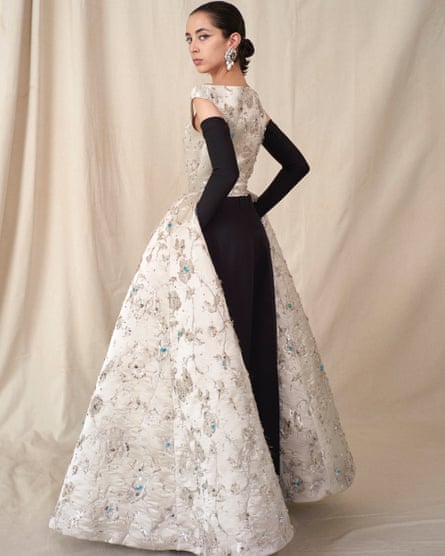Balenciaga seeks to reset the narrative with haute couture revival
In his six years at Balenciaga, the Georgian fashion designer Demna Gvasalia has put Crocs plastic sandals and Bernie Sanders campaign merchandise on the Paris catwalks. The windows of the Avenue Montaigne boutique have framed a £1,600 version of Ikea’s distinctive blue nylon Frakta tote bag and, this season, a £2,000 hi-vis jacket in lurid yellow nylon.

One of Demna Gvasalia’s haute couture creations being modelled in Paris.
Photograph: Balenciaga
This week, in his strangest move to date, Gvasalia revived the haute couture branch of Balenciaga, which closed in 1968. Haute couture, where taffeta ballgowns are created to fit the tastes and measurements of the monied elite, seems an unlikely area of interest for the designer, whose first Balenciaga show half a decade ago kickstarted a global renaissance for the puffer jacket that is still going strong.
This was always going to be a different kind of couture show. Ella Emhoff, stepdaughter of the US vice-president, Kamala Harris, was one of the models, wearing a padded silk opera jacket over a tuxedo. Kanye West, in the front row, wore a balaclava throughout. There were more buzz cuts than updos.
The show opened with a series of trouser suits, some worn by men, some by women. A filmy, unstructured vest-dress stood in for a ballgown, a fluffy pastel dressing gown for a coat. The dystopian note that rings through every Balenciaga show seemed in eerie harmony with the pandemic zeitgeist. The outsize, opaque, goggle-style sunglasses on the runway looked almost normal in a room where most of the audience had half of their faces obscured under masks.
But the biggest surprise was that this was in many ways a very traditional couture show. The venue was an apartment that the label’s founder, Cristóbal Balenciaga, once used for shows, repurposed in recent years as a storeroom. Rather than stripping it out and remodelling the space, Gvasalia had it restored to its 1960s hushed elegance, complete with pale bourgeois carpets and soft drapes at the windows.

A model in a Balenciaga gown at the label’s haute couture show in Paris.
Photograph: Balenciaga
The small live audience took their seats on delicate gilt chairs, watched by viewers on a livestream where the footage was set to Red Garland’s jazz piano bar classic Almost Like Being In Love.
A denim jacket came with a traditional Balenciaga silhouette, the collar rolled and tugged open at the rear to reveal the nape of the neck; the matching five-pocket jeans had buttons in solid silver rather than aluminium. A floral-embroidered silk ballgown worn with opera gloves was based on a piece made for Jackie Kennedy.
The bride who closed the show, as is traditional in haute couture, wore a two-piece in the waist-obliterating double-balloon silhouette with which Balenciaga himself scandalised Paris over half a century ago.
The logic behind this expensive investment in a new catwalk platform is that Balenciaga, along with the industry’s other most traditionally prestigious names, urgently needs to regain control of the fashion narrative. During the pandemic, fashion weeks have gone dark and the traditional seasonal calendar has lost its relevance. Trends have been led by Nike and Netflix, rather than by the usual fashion week names. The reopening of haute couture represents Balenciaga pulling rank over those pretenders.
Speaking to the Business of Fashion website in advance of the show, Gvasalia said he saw reviving fashion in its most expensive form as an “anti-consumption” move. “Maybe somebody just stops buying sneakers and T-shirts for a year or two, and then they can have this amazing couture trench coat. I would love that,” he said.






